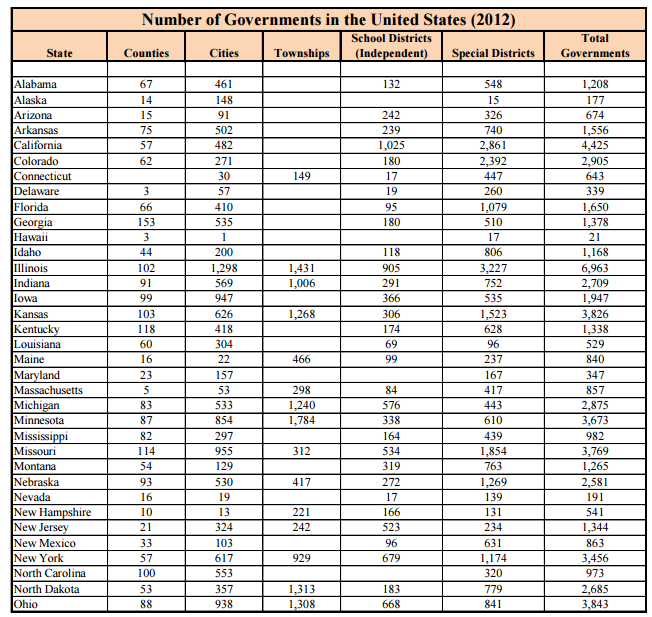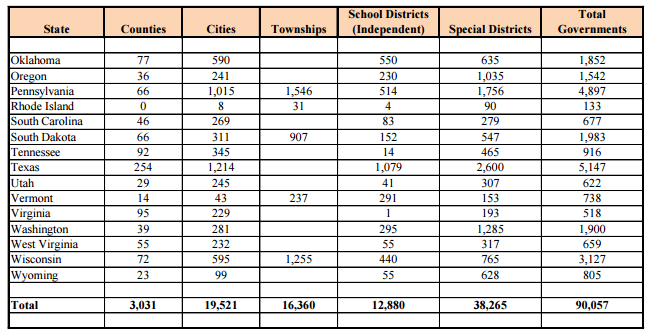Everyone Can and Should Do It
As start-ups scramble to find customers for their goods and services, all too often the managers overlook one of the best potential customers, i.e., local governments.
When they think about seeking government customers, most businesses consider the federal government or perhaps the state, because bigger seems better. What managers may not realize is that there are over 90,000 units of local government in the United States. That makes local government a target rich environment with nearly 20,000 cities, over 3,000 counties, and almost 13,000 school districts. Add to that the in excess of 16,000 townships (a more limited form of local government found in 22 states) and over 38,000 special districts (e.g., community college districts, housing authorities, and utilities) and there are endless opportunities for you to get government customers.
Many of these local governments are desperate to find local vendors, small businesses, and/or minority, veteran, and women owned enterprises. Most also are eager to find “green products.” So they will welcome you with open arms.
But how do you find out about sales opportunities with them? How do you develop a cost-effective marketing strategy to tap this marketplace? Here are several ways to do it.
1. How to Find Local Governments That Could Be Potential Customers – Let Your Fingers Do the Walking
First, you can use the old, old-fashioned way. Grab a phone book (if you can find one), flip to the government section, and start googling or telephoning the listed entities. If you don’t have a telephone book handy, State and Local Government on the Net offers extensive links to state government agencies and many local governments.[1] (Later in this article, I’ll give you additional sources to use on a state-by-state basis.)
Most of the larger governments will have a section of their home page devoted to procurement which will describe how you register to receive bid notifications. Active solicitations should be listed online as well. If they aren’t online, call the purchasing office (if it’s not free standing, it’s typically part of a finance office). The purchasing staff will be happy to help walk you through the process.
Even if the bids are online, call the purchasing office, especially if you are a local vendor, small business, or minority, veteran, or woman-owned business. Alert them to your interest and inquire about any training sessions they may have for new bidders. Purchasing practices may vary by type of good or service to be purchased, the dollar value of the purchase, the urgency of need, and a host of other factors. State law may control how some items are procured. Ask the purchasing staff to explain these policies to you. Ask for a detailed description of the requirements to qualify for preferences that might be accorded to your company if it is a small business, or minority, veteran, or woman owned.
Know the policies and requirements like the back of your hand. If you are a minority, veteran, or women owned business, a small business, or perhaps from some other favored category, make certain you register for those special preferences. It means business.
Some purchases must be done through a competitive, advertised bid process. Others, especially the smaller dollar purchases, may be processed through more informal means (e.g., calling three vendors on their vendor registry and asking them to submit bids). The informal bidding opportunities are the ones you don’t want to miss. Ensure that the purchasing staff know of your interest in selling to their government and have a clear understanding of your products and services.
2. How to Find Local Governments That Could Be Potential Customers – Bid Notification Services
There are dozens, if not several hundred, companies that offer to notify you of federal/state/local government bid opportunities around the nation. Those services arrange to receive all the advertisements from various local, state, and federal government agencies around the nation, then share those bid notifications with all of their subscribers.
Check with your local governments to see which bid notification services they may recommend. A former client of mine, Vendor Registry, is among the smaller companies that may be a good match for a small business just entering the government marketplace.[2] Coverage for each bid notification service varies widely. (Vendor Registry, for example, includes bids from governments in 20 states although it is expanding fairly rapidly across the US.) So investigate closely before you pick the service(s) you will use.
3. Learn More About the Marketplace – Specialized Consulting Firms and Publications
Other companies will share with you special insights into the buying strategies of states and local governments – for a price. Strategic Partnerships, Inc.,[3] an Austin, Texas company provides a full range of services designed to help customers score a big share of the government marketplace. Onvia is another company, more national in scope, that also provides high end consulting services.[4] Smartprocure.com offers a similar market basket of data and services[5] and does Bidsync.[6] The latter, however, also offers free bid notifications with their other fee based services.
For most readers, the services of those companies may be out of reach. Publications like American City and County,[7] Governing,[8] and Government Technology[9], however, are additional sources of information and insights through not only the publications but also events and webinars they sponsor.
4. Learn More About the Marketplace – Professional Associations and Support Agencies
A. Educational Agencies. In addition to the local governments themselves, a host of service agencies have sprung up to perform specialized functions for them. Thirty-five states (35) have 560 entities that provide a variety of services to school districts (e.g., operating purchasing pools or offering information technology services). In Nebraska, for example, these organizations are called Educational Service Units. New York labels theirs Boards of Cooperative Educational Services (BOCES).
B. Planning Organizations. Regional councils (aka councils of government) provide specialized services to cities and counties across the nation. As defined by the National Association of Regional Councils, they are “a multi-service entity with state- and locally-defined boundaries that delivers a variety of federal, state, and local programs while carrying out its function as a planning organization, technical assistance provider.” Established in all 50 states and the District of Columbia, the councils are heavily identified with transportation planning. But many have broad programmatic responsibilities (e.g., emergency response and social service delivery). A host of them also provide cooperative purchasing for their members and/or run purchasing pools for local governments.
C. Professional Associations. Since I began my consulting career 20 years ago, one of the most notable changes has been in the explosion of associations that serve state and local government and education administrators and officials. I’ve identified nearly 1,600 national and state level organizations that serve not only cities, counties, school districts, and colleges/universities, but also every type of elected official or professional employed by such entities (e.g., coroners and human resource directors).
That’s good news for companies seeking to sell their goods and services into this sector because these groups, first and foremost, provide contact information for their membership (many may have links to all members on their web page). Business may advertise in association publications, participate in trade shows held in conjunction with association meetings, and/or sponsor seminars or workshops for the organization. Anyone planning a state/local government marketing campaign should utilize heavily the opportunities available through these associations.
D. Purchasing Pools. In an effort to maximize their purchasing power, governments increasingly are joining together to form cooperative purchasing organizations or pools. My first consulting client 20 years ago was the group that set up the Buy Board, the purchasing pool that now serves more than 4,600 entities in Texas, including not only public sector agencies but also charter schools and non-profit organizations. Pools, therefore, offer tremendous sales opportunities to you as well. My most recent search identified 128 pools of various sizes operating across the US (and no doubt more are in the pipeline).
5. Jump In!
State and local government agencies need a diverse pool of vendors offering an almost endless array of products and services to them. If you’d like to begin or expand a state/local government marketing program, I’m putting some of the key resources I’ve developed over the last 20 years into a “Starter Kit” for you. For $99.59 (tax included – check only), you’ll receive a comprehensive state and local government acronym guide (more than 1,100 of those perplexing acronyms) and glossary (in excess of 250 of the baffling terms); the contact lists mentioned in items 4a – d (2,800 associations, educational service units, purchasing pools, and regional councils); and state by state listings of fiscal years, population, and other useful information. That should give you a well-organized, but affordable, start to your marketing effort.
Don’t wait! Many governments end their fiscal years on June 30th, so this is prime time to get in on those last minute sales opportunities!
[1] http://www.statelocalgov.net.
[2] https://vendorregistry.com
[3] http://www.spartnerships.com.
[4] https://www.onvia.com.
[5] https://smartprocure.us.
[6] https://www.periscopeholdings.com/bidsync.
[7] http://americancityandcounty.com.
[8] http://www.governing.com.
[9] http://www.govtech.com.
Find a Home-Based Business to Start-Up >>> Hundreds of Business Listings.


















































